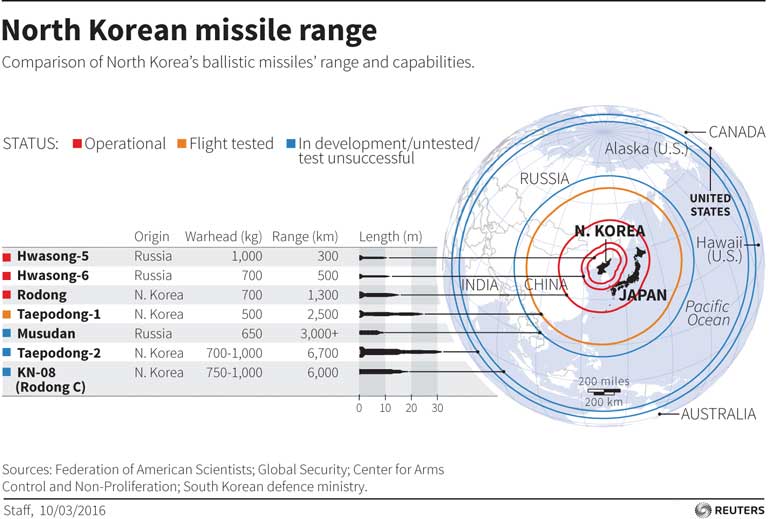Wednesday Feb 12, 2025
Wednesday Feb 12, 2025
Thursday, 23 June 2016 00:00 - - {{hitsCtrl.values.hits}}

Reuters: North Korea launched what appeared to be a second intermediate-range Musudan missile on Wednesday that flew about 400 km (250 miles), in what appeared to be its most effective test yet, hours after another launch failed, South Korea’s military said.
It was not immediately clear if the second Musudan launch, about two hours after the first, was considered a success or failure, or how the flight ended. However, the distance it covered was theoretically more than halfway towards the southwest coast of Japan’s main Honshu island.
The first missile was launched from the east coast city of Wonsan, a South Korean official said, the same area where previous tests of intermediate-range missiles were conducted, possibly using mobile launchers.
Yonhap, quoting a government official, said it disintegrated mid-air after a flight of about 150 km (95 miles).
The launches were in continued defiance of international warnings and a series of U.N. Security Council resolutions that ban the North from using ballistic missile technology, which Pyongyang rejects as an infringement of its sovereignty.
Wednesday’s first launch would have been the fifth straight unsuccessful attempt in the past two months to launch a missile that is designed to fly more than 3,000 km (1,800 miles) and could theoretically reach any part of Japan and the U.S. territory of Guam.
However, Jeffrey Lewis of the California-based Middlebury Institute of International Studies, said failures were a normal part of testing and that North Korea would fix the problems with the Musudan sooner or later.
“If North Korea continues testing, eventually its missileers will use the same technology in a missile that can threaten the United States,” Lewis told Reuters.
Serious provocation
Japanese Defence Minister Gen Nakatani told reporters in Tokyo that North Korea’s repeated missile launches were a “serious provocation” and could not be tolerated.
He said further provocative action from Pyongyang could not be ruled out, and suggested the twin launches could have been timed to coincide with the 66th anniversary of the start of the Korean War in 1950.
Japan had indicated after the first launch that it would protest strongly because it violated a United Nations resolution. While the launches posed no threat to Japanese security, Nakatani also said repeated failures indicated possible problems with the missiles’ engines.
In Seoul, South Korea’s presidential office said a national security meeting would be convened later on Wednesday morning to discuss the latest missile launches.
The U.S. military detected the two missiles, most likely Musudan, from North Korea, the U.S. military’s Pacific Command said. A Pentagon spokesman said the missiles both fell into the Sea of Japan.
Japan put its military on alert on Tuesday for a possible North Korean ballistic missile launch. South Korea’s Yonhap News Agency, citing an unidentified government source, said the North had been seen moving an intermediate-range missile to its east coast.
North Korea is believed to have up to 30 Musudan missiles, according to South Korean media, which officials said were first deployed around 2007, although the North had never attempted to test-fire them until April. The U.N. Security Council, backed by the North’s main diplomatic ally, China, imposed tough new sanctions in March after the isolated state conducted its fourth nuclear test in January and launched a long-range rocket that put an object into space orbit.
North Korea has conducted a series of tests since then that it claimed showed progress in nuclear weapons and long-range ballistic missile capabilities, including new rocket engines and simulated atmospheric re-entry.
The two Koreas technically remain in a state of war after the 1950-53 Korean War ended in an armistice, not a peace treaty.
A spokesman for South Korea’s Unification Ministry said North Korea should channel its efforts into the welfare of its people and peace on the Korean peninsula rather than developing its missile technology.
 SEOUL (Reuters) - South Korean President Park Geun-hye said on Wednesday that North Korea was heading towards self-destruction with its continued missile and nuclear tests.
SEOUL (Reuters) - South Korean President Park Geun-hye said on Wednesday that North Korea was heading towards self-destruction with its continued missile and nuclear tests.
“The North Korean regime should realise that complete isolation and self-destruction await at the end of reckless provocation,” Park said.
Her remarks come after North Korea launched what appeared to be a second intermediate-range Musudan missile on Wednesday that flew about 400 km (250 miles).
Discover Kapruka, the leading online shopping platform in Sri Lanka, where you can conveniently send Gifts and Flowers to your loved ones for any event including Valentine ’s Day. Explore a wide range of popular Shopping Categories on Kapruka, including Toys, Groceries, Electronics, Birthday Cakes, Fruits, Chocolates, Flower Bouquets, Clothing, Watches, Lingerie, Gift Sets and Jewellery. Also if you’re interested in selling with Kapruka, Partner Central by Kapruka is the best solution to start with. Moreover, through Kapruka Global Shop, you can also enjoy the convenience of purchasing products from renowned platforms like Amazon and eBay and have them delivered to Sri Lanka.
Discover Kapruka, the leading online shopping platform in Sri Lanka, where you can conveniently send Gifts and Flowers to your loved ones for any event including Valentine ’s Day. Explore a wide range of popular Shopping Categories on Kapruka, including Toys, Groceries, Electronics, Birthday Cakes, Fruits, Chocolates, Flower Bouquets, Clothing, Watches, Lingerie, Gift Sets and Jewellery. Also if you’re interested in selling with Kapruka, Partner Central by Kapruka is the best solution to start with. Moreover, through Kapruka Global Shop, you can also enjoy the convenience of purchasing products from renowned platforms like Amazon and eBay and have them delivered to Sri Lanka.